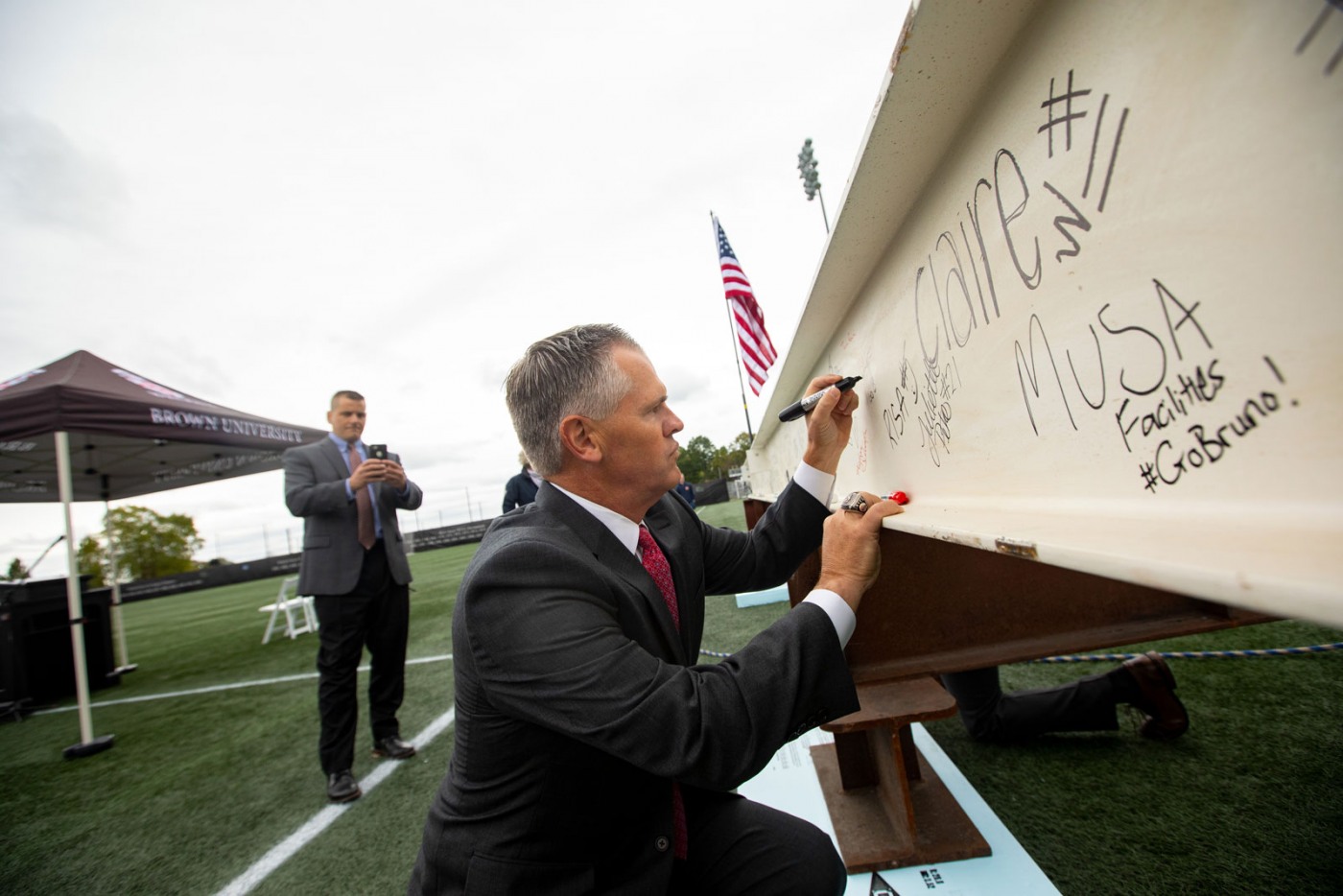PROVIDENCE, R.I. [Brown University] — Since ground was broken in June 2019, construction progress on Brown University’s Center for Lacrosse and Soccer has outpaced every prediction. Leaders from Facilities and Athletics now expect the center to be fully functioning by the start of the Spring 2020 lacrosse season.
On Thursday, Oct. 3, a crane lifted the structure’s final steel beam — decorated with the signatures and well wishes of student athletes, University leaders, construction workers and community members involved in the project’s planning and development — into place. In the spirit of topping-off tradition, an American flag and small pine tree sat atop the beam as it moved into position.

Brown President Christina Paxson and Athletics Director Jack Hayes joined project partners, supporters and the student-athletes who will benefit directly in celebrating the milestone.
“The rise of this center is a marker of the impressive progress we’re making here in upgrading our campus and our Athletics facilities,” Paxson said. “And it reflects our genuine commitment to enhancing the student-athlete experience and the competitiveness of our sports teams.”
The Center for Lacrosse and Soccer at Stevenson-Pincince Field will serve as a dedicated home for Brown’s men’s and women’s teams in each sport, providing them with ample space and state-of-the-art amenities for practice, training and competition.
Lacrosse and soccer facilities are currently spread across multiple buildings, none of which are adjacent to Stevenson-Pincince Field. The central location of the new center will eliminate the need for student-athletes to trek between buildings, allowing them more practice time.
The four teams boast a combined 42 Ivy League championships and 47 NCAA tournament appearances, and Paxson said she hoped the new facility would serve to boost those numbers.
“Building on that success, this center is going to position us at the highest level of competition,” she said. “It will enhance the camaraderie and cohesion that really makes for great athletics teams.”
The planned three-story, 22,500-square-foot center will include team locker rooms, coaches’ offices and team meeting spaces, and spectators will benefit from a new grandstand, scoreboard, concessions area and restrooms.
Andrew Cortes, creator and director of the Building Futures Rhode Island, was among the speakers during the topping-off ceremony. Founded in 2007, Building Futures developed an apprenticeship program that trains and supports Ocean State residents from low-income backgrounds who are transitioning into construction careers.
Cortes was quick to point out that construction projects like these impact far more than just the immediate Brown community.
“Everybody’s aware of the high-quality post-secondary education that happens within Brown University’s walls,” Cortes said. “But not too many people are aware that post-secondary education is happening while we construct those walls through registered apprenticeship — the other four-year degree.”
Cortes noted that nearly every single graduate of Building Futures — of which there are more than 300 — has spent time working on a construction project at Brown, given the University’s growth in recent decades. According to data from the organization, apprentices have worked more than 171,000 hours on Brown projects since the program’s launch.
“The University has been the single biggest client that Building Trades has serviced in my tenure, and probably the tenure of presidents before me,” said Michael Sabitoni, president of the Rhode Island Building and Construction Trades Council. “No single entity has had a bigger impact on the Building Futures program than Brown University.”
Sabitoni pointed to ironworker Tim Sanders, a Building Futures cadet on hand for the topping-off ceremony who made his mark on the Center for Lacrosse and Soccer thanks to a Brown policy that ensures every University project over $5 million hires apprentices through the program.
“That’s not just investing in the buildings, but the men and women who build them,” Sabitoni said.